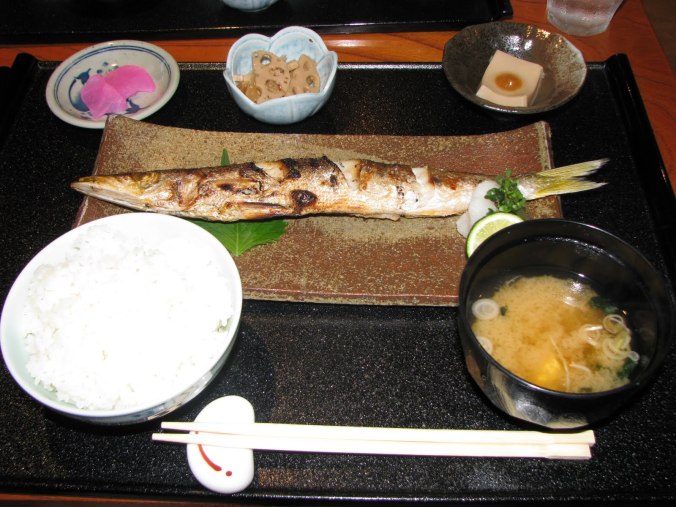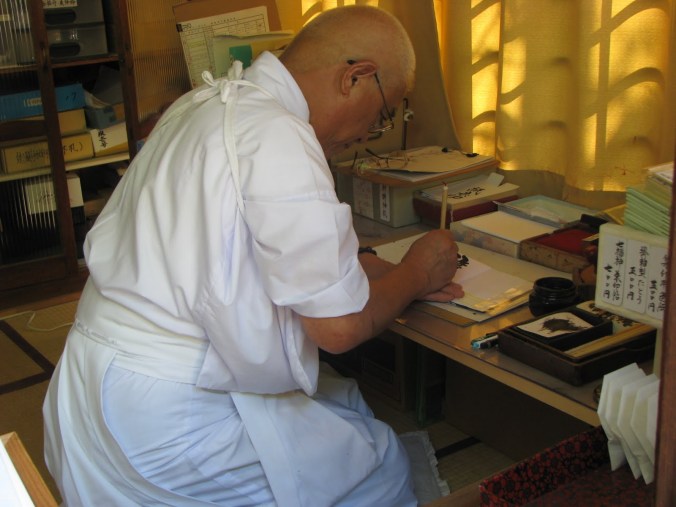Sunday, September 6, 2009: Our first full day of sight-seeing was indeed a full day! We started the day with a very traditional breakfast of rice balls with plum or soy sauce, seaweed to wrap around the rice balls and miso soup with mushrooms. Then,the whole family loaded into a van and off we went to visit the city of Kamakura, about an hour south from Yokohama.
Upon arriving in  Kamakura, we ate lunch. The presentation of their meals is so artistic. I just loved the little dishes. This was my lunch of fish, rice, miso soup, pickled cabbage and a gelatin type of dessert. I am proud to report that David and I ate with chopsticks the whole trip. It was very challenging at first and there were times, when I was extremely tired that I couldn’t get them to work. However, for the most part, we were very successful.
Kamakura, we ate lunch. The presentation of their meals is so artistic. I just loved the little dishes. This was my lunch of fish, rice, miso soup, pickled cabbage and a gelatin type of dessert. I am proud to report that David and I ate with chopsticks the whole trip. It was very challenging at first and there were times, when I was extremely tired that I couldn’t get them to work. However, for the most part, we were very successful.
Kamakura was founded in 1192 and was the capital of Japan until 1333. Thankfully, it was spared Allied bombing during World War II and today it is home to 65 temples and 19 shrines.
 The first shrine that we visited was Tsurugaoka Hachiman-gu. This shrine was founded by Minamoto Yoriyoshi who was from the Minamoto clan that ruled Japan from Kamakura starting in 1185. My gosh, the Japanese history is so complex with all the different periods, shoguns or rulers who inevitably moved the capital to a different city! I have two guide books to do research to make certain I am entering this information correctly!!!! Anyway, the grounds to this shrine were lovely. There was a wide walkway to get to the steps that led to the building. Off to the right and left were smaller buildings where people posted various prayer request. We crossed over the Gempei Pond on a traditional Japanese bridge. The pond had koi fish and lotus plants. Lotus flowers are important in the Buhhdist religion. A lotus plant often grows in dirty water. Due to this, the lotus flower symbolizes that a person can rise above being rooted in the ugliness and suffering in the world and should try to be pure and help others with the beauty of the spirit. The koi fish because of its strength and determination represents courage and ability to attain high goals. However, others think the koi are for good luck. I like the courage and attaining high goal idea best!
The first shrine that we visited was Tsurugaoka Hachiman-gu. This shrine was founded by Minamoto Yoriyoshi who was from the Minamoto clan that ruled Japan from Kamakura starting in 1185. My gosh, the Japanese history is so complex with all the different periods, shoguns or rulers who inevitably moved the capital to a different city! I have two guide books to do research to make certain I am entering this information correctly!!!! Anyway, the grounds to this shrine were lovely. There was a wide walkway to get to the steps that led to the building. Off to the right and left were smaller buildings where people posted various prayer request. We crossed over the Gempei Pond on a traditional Japanese bridge. The pond had koi fish and lotus plants. Lotus flowers are important in the Buhhdist religion. A lotus plant often grows in dirty water. Due to this, the lotus flower symbolizes that a person can rise above being rooted in the ugliness and suffering in the world and should try to be pure and help others with the beauty of the spirit. The koi fish because of its strength and determination represents courage and ability to attain high goals. However, others think the koi are for good luck. I like the courage and attaining high goal idea best! This was one of my favorites for the day. The walls and stairway leading to the temple are lined with jizo statues. The jizo is the patron diety of travelers and children. I just think they are so cute….however, what these statues are placed for is so sad. They are placed by women who lost children either through a miscarriage or abortion. Often, the statues will have clothing to keep them warm or toys next to them. I guess since it was a hot and humid time of year in Japan, none of them had clothes on them.
This was one of my favorites for the day. The walls and stairway leading to the temple are lined with jizo statues. The jizo is the patron diety of travelers and children. I just think they are so cute….however, what these statues are placed for is so sad. They are placed by women who lost children either through a miscarriage or abortion. Often, the statues will have clothing to keep them warm or toys next to them. I guess since it was a hot and humid time of year in Japan, none of them had clothes on them.  Finally, we visited one of the two largest bronze Buddha pre-modern bronze statues in Japan. It was cast in 1252 and is 37 ft tall. It once was housed in a large wooden hall, but that building was swept away by a tidal wave in 1495. It must have been one heck of a tidal wave…we were near the water, but still quite a distance from the shore. I just can’t imagine and the fact that the statue remained….divine intervention??? You decide.
Finally, we visited one of the two largest bronze Buddha pre-modern bronze statues in Japan. It was cast in 1252 and is 37 ft tall. It once was housed in a large wooden hall, but that building was swept away by a tidal wave in 1495. It must have been one heck of a tidal wave…we were near the water, but still quite a distance from the shore. I just can’t imagine and the fact that the statue remained….divine intervention??? You decide.
One of my most cherished souvenirs is the book which I started at  Kamakura. You can purchase a plain book from any of the temple or shrine areas. As you visit the different temples or shrines throughout Japan, there are stalls that you can go to and a monk will sign your book, for about $3.00 in calligraphy. He writes the date, name of the temple/shrine in black and then, with red ink, stamps it with a large round or square stamp. I had my book signed probably at 12 places. I can’t begin to tell you where each page was from, but that doesn’t matter as each signature is so beautiful. I will enjoy this book for a long, long time.
Kamakura. You can purchase a plain book from any of the temple or shrine areas. As you visit the different temples or shrines throughout Japan, there are stalls that you can go to and a monk will sign your book, for about $3.00 in calligraphy. He writes the date, name of the temple/shrine in black and then, with red ink, stamps it with a large round or square stamp. I had my book signed probably at 12 places. I can’t begin to tell you where each page was from, but that doesn’t matter as each signature is so beautiful. I will enjoy this book for a long, long time.
So, we had a full day of sightseeing in Kamakura and when we were  heading back to Yokohama City, we thought we were returning to the condo. Junichi, Michiko’s husband, wanted to show their Chinatown. It is Japan’s largest. It was certainly a busy, crowded place. We got there after dark and it was fun walking through the narrow streets with the colorful lanterns . Dinner was at a Chinese restaurant. We had a private dining room, which was fun. Junichi ordered enough food to feed an army! The table had a large lazy susan in the middle and we were able to turn it to try the various dishes that he had decided on. Everything was delicious.
heading back to Yokohama City, we thought we were returning to the condo. Junichi, Michiko’s husband, wanted to show their Chinatown. It is Japan’s largest. It was certainly a busy, crowded place. We got there after dark and it was fun walking through the narrow streets with the colorful lanterns . Dinner was at a Chinese restaurant. We had a private dining room, which was fun. Junichi ordered enough food to feed an army! The table had a large lazy susan in the middle and we were able to turn it to try the various dishes that he had decided on. Everything was delicious.
The day ended by visiting a Japanese grocery store. It was the same concept as our grocery stores, push the cart, pick out what you want, pay for it and then you wheeled your cart to another area, where you bagged your purchase. We couldn’t always figure out what certain foods were, but when we did, we compared prices. Some items were comparable, but other food items, like fruit, were very expensive. A bunch of grapes were about $40!, apples were anywhere from $1-$2 each.